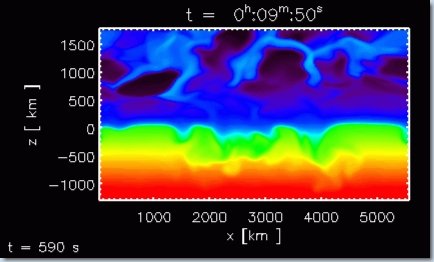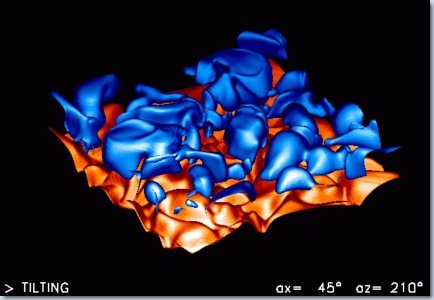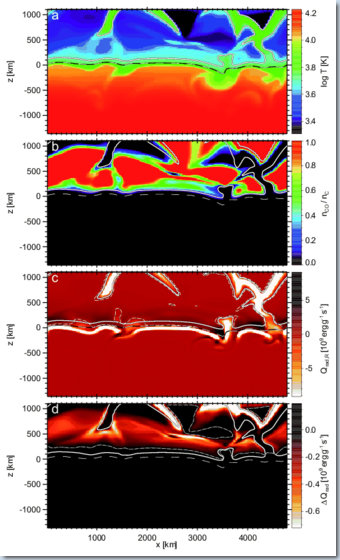|
Carbon monoxide (CO) has been observed in the solar atmosphere
for more than 30 years. The discovery of strong CO lines in the
early 1970s provoked a crisis in our understanding of the thermal
structure of the outer layers of the Sun and solar-type stars:
The very existence of CO molecules in significant amounts requires
much lower gas temperatures than predicted by the standard
models of the solar atmosphere.
Due to its strong infrared line emission, carbon monoxide is known to
be an efficient cooling agent that can actively affect the thermal
state of the atmospheric gas itself. Therefore, the idea that CO is
capable of inducing large horizontal temperature differences in the
solar atmosphere has attracted considerable attention during the past
three decades.
The scenario is as follows: A small perturbation towards lower
temperature would lead to the formation of more CO molecules, whose
infrared lines would further cool the gas and thus induce the
formation of even more CO, ultimately leading to a "cooling
catastrophe". CO could thus enforce a very cool equilibrium
temperature in quiet regions where radiative equilibrium conditions
prevail. In more active regions with a critical amount of mechanical
heating, e.g. through to the dissipation of acoustic waves, CO molecules
are destroyed and the atmosphere switches over to a hot state.
In an effort to verify that this cooling instability is really at work
in the Sun, and is responsible for the existence of cool patches in
the lower chromosphere, Sven Wedemeyer-Böhm
(Kiepenheuer-Institut
für Sonnenphysik, Freiburg) and Matthias Steffen
(Astrophysikalisches Institut Potsdam, AIP) have carried out the
hitherto most sophisticated numerical simulations of this process,
using the computer code CO BOLD. This code, developed partly at the
AIP, combines time-dependent hydrodynamics, detailed radiative
transfer including CO line cooling, and a non-equilibrium chemical
reaction network into a 2- or 3-dimensional model of the solar
atmosphere. BOLD. This code, developed partly at the
AIP, combines time-dependent hydrodynamics, detailed radiative
transfer including CO line cooling, and a non-equilibrium chemical
reaction network into a 2- or 3-dimensional model of the solar
atmosphere.

Temperature distribution in a vertical cross-section
in a CO BOLD simulation of the solar atmosphere, showing the
violent dynamics of the outer layers. BOLD simulation of the solar atmosphere, showing the
violent dynamics of the outer layers.

3-dimensional distribution of carbon monoxide (blue) and
temperature (red) in a CO BOLD simulation of the solar atmosphere. BOLD simulation of the solar atmosphere.
[Stellar physics program]
[AIP home page]
|
|

Two-dimensional slices for an exemplary time step
a) logarithmic gas temperature log T, b) fraction of carbon
atoms bound in CO, c) net radiative heating rate for the
simulation without CO line cooling, and d) the difference of radiative
heating rates between the runs with and without CO cooling.
|
Main result:
If the atmospheric dynamics is artificially suppressed, the CO cooling
process works in principle and drives the atmosphere to a very cool
radiative equilibrium state, as expected. However, the radiative
relaxation of the atmosphere to a cool state is a slow process that
takes several 1000 s. The situation is completely different in
the fully dynamical simulations. Here the effect of CO cooling is
found to be almost negligible. This is not so surprising
since the dynamical timescales in the solar atmosphere model are of
the order of 30 seconds, much too short to permit the radiative
relaxation to a cool state.
The authors conclude that the beautiful idea to explain the very cool
temperature regions observed in the solar atmosphere as a result of a
thermal instability due to carbon monoxide as a cooling agent seems to
be invalid. Rather, the new calculations indicate that it is the
violent dynamics of the outer model atmosphere that produces the
inhomogeneous thermal structure by means of shock wave heating and
expansion cooling. A similar conclusion probably holds for other
solar-type stars.
Contact
Dr Matthias Steffen
Astrophysikalisches Institut Potsdam
An der Sternwarte 16
D-14482 Potsdam
(0331) 7499 371

|
|


 last change 2007 February 1, R. Arlt
last change 2007 February 1, R. Arlt


